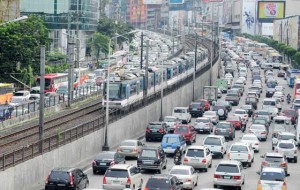IF you think the traffic nightmare in Metro Manila can’t get any worse, think again.
Chairman Francis Tolentino of the Metropolitan Manila Development Authority (MMDA) admitted on Tuesday that the traffic situation has become unmanageable and will worsen next year if the agency will not be given additional funds to enable it to hire more personnel.
Speaking at the Bulong Pulungan media forum at the Sofitel Hotel in Pasay City (Metro Manila), Tolentino said the MMDA will be needing volunteers to man traffic on Edsa, Katipunan, Roxas Boulevard and other major thoroughfares if the agency will not be able to get back the 15 percent slashed from the MMDA’s budget for 2015.
“I want you to realize that the current traffic situation is really unmanageable when we lack three items. Number one, budget. MMDA’s budget for 2015 was slashed by 15 percent. If we don’t get that 15 percent [back], we will need volunteers to man Katipunan, to man Roxas Boulevard. That is why I volunteered for the last two days to man traffic myself. It will be hard next year,” he told the media forum.
Tolentino said Metro Manila also needs an additional 137 kilometers of new roads as proposed by the Japanese-initiated transportation roadmap called the Dream Plan.
According to the MMDA chairman, some residential subdivisions should be opened to vehicular traffic during certain hours.
“Maraming magagalit [Many from such subdivisions will get angry] but that’s the bitter pill that we have to swallow,” he said.
Tolentino said Metro Manila needs a “leapfrogging” in the mass transit system.
“So when we speak of modernization, I think big corporations should be involved. The government probably might find it long and difficult to shoulder the entire burden of modernizing the mass transit system,” he noted.
The MMDA chief said plans for subway systems are in the works.
“I believe the subway system will help. Flooding would not be an issue even if you dig 10 or 30 meters in Edsa. But we need huge investments apart from the P2.6 trillion mentioned by the Dream Plan,” he added.
The Japan International Cooperation Agency (JICA) initiated Dream Plan, which calls for an investment of P2.6 trillion to decongest traffic.
Tolentino said the Dream Plan coincides with the MMDA’s project called “Greenprint 2030.”
The Dream Plan seeks the construction of 137 kilometers of new roads for Metro Manila, 78 kilometers of urban expressways and 200 kilometers of new light railway system that will include the Light Rail Transit 1 extension going to Bacoor, Cavite, and Metro Rail Transit 7 going to San Jose del Monte, Bulacan.
The first part of the plan involves a P520-billion short-term program of decongesting traffic between now and 2016.
The short-term program contains proposals to fill missing links in major thoroughfares, expand expressways serving as entrances to Metro Manila and develop rail and road-based mass transport systems, among others.
In the same forum, Megaworld senior vice president Jericho Go commended the MMDA for implementing a new traffic scheme in Eastwood City and Libis along C5 in Quezon City.
According to Go, the flow of vehicles going to Eastwood City and nearby Libis area greatly improved after the MMDA reactivated its synchronized traffic light system on several intersections along E. Rodriguez Jr. Ave (C-5) including Calle Industria, Greenmeadows, Lanuza and Eastwood City.
He said the implementation of the new scheme has produced immediate results with more motorists reporting that their travel time going to Eastwood City has been reduced by more than half.


